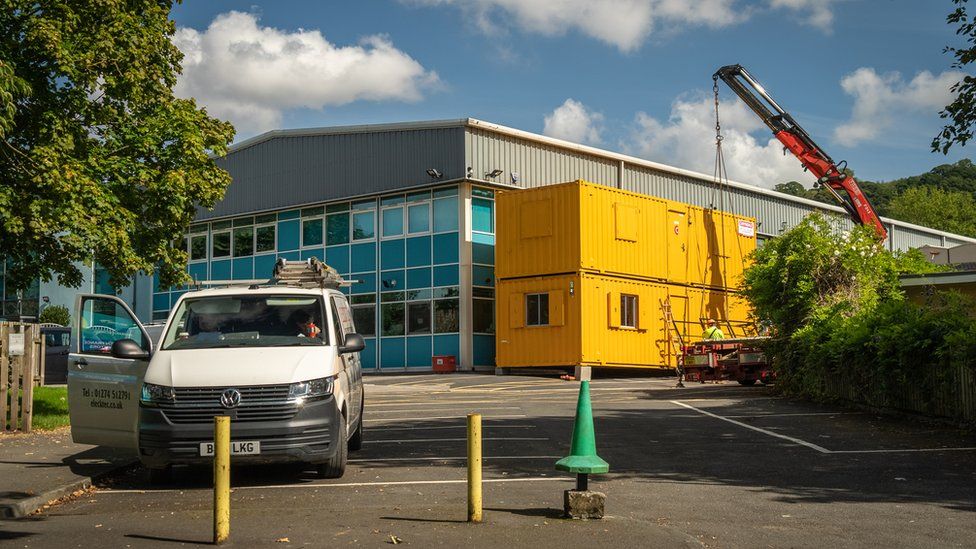ARTICLE AD BOX
 Image source, BBC / Ed Lawrence
Image source, BBC / Ed Lawrence
Crossflats Primary in Bradford is among the schools affected
By Hazel Shearing
Education correspondent
Parents have described their shock of being told their children's schools need to close due to the risk of dangerous concrete collapses.
More than 100 schools have been told to close areas affected by reinforced autoclaved aerated concrete (RAAC) without safety measures in place.
It follows the collapse of a beam that was previously thought to be safe.
It unclear how many schools have had to fully close, but it could be as many as 24.
The number identified with RAAC could rise as more surveys are carried out.
The government says parents at 156 schools confirmed to have RACC should have already been contacted. Of the total, 52 were deemed a critical risk, and safety measures have already been put in place.
Asked on BBC Breakfast whether buildings at those 52 schools "could have potentially collapsed", schools minister Nick Gibb said: "Yes, and that's why we took action."
The rest were deemed to be "non-critical", and were told to develop contingency plans in case buildings needed to close.
But on Thursday, those schools were told to close buildings and rooms with RAAC unless they had safety measures in place - which could include propping up ceilings.
The government has not said when a list of affected buildings will be published, drawing criticism from the Labour Party - but the BBC has been compiling its own.
Mr Gibb told BBC Radio 4's Today programme the guidance changed because "a beam that had no sign... that it was a critical risk and was thought to be safe collapsed".
The incident took place last week, but it is not clear where.
But the Department for Education (DfE) has not given a timeline for replacing the RAAC, which was widely used until the mid-90s.
There are more than 20,000 schools in England.
Martina Eliasova's daughter was meant to start Year Two at Katherines Primary Academy in Harlow next week, but the start of term of term has been pushed back to 11 September.
"I was a bit shocked. I can work from home... it'll be difficult because she's only six," she tells the BBC.
"I don't have family here. I can't say 'mum, can you help my daughter?' I have to either take holiday, or just have her home and somehow battle through."
Sam Fitzjohn, whose daughter is also a pupil at Katherines Primary Academy, said the decision "seems to be last-second".
"For some of us that are working, we've got to work around work, as well as organising children.
"If it was at the beginning of the holiday and they said, 'look, we've found this problem and it might take longer' we might have had time to plan around it," he said.
Wendy Kirwood said her son's school in Workington, Cumbria, will have an inset day next week.
"We've been told that four corridors, the library and sports hall are affected," she said.
"This is an absolute disgrace. Why has it taken until the end of the summer holidays to bring this to the table? We are in shock."
Shadow education secretary Bridget Phillipson, who said Labour had not seen the full list of schools with confirmed RAAC, urged ministers to "come clean with parents and set out the full scale of the challenge that we're facing".
On Thursday, Education Secretary Gillian Keegan said affected schools would contact parents directly, adding: "If you don't hear, don't worry."
She said the plan would "minimise the impact on pupil learning and provide schools with the right funding and support they need to put mitigations in place to deal with RAAC".
Watch: Education secretary tells parents not to worry
He said it would be a "challenge" to replace three schools just days before the start of term, adding that "we're working on that now".
Teachers' unions have criticised the DfE for making the call so close to pupils returning to school.
The risk of injury or death from a school building collapse was said to be "very likely and critical" by the watchdog the National Audit Office (NAO) in June.
RAAC is a lightweight "bubbly" form of concrete used widely between the 1950s and mid-1990s - usually in the form of panels on flat roofs, as well as occasionally in pitched roofs, floors and walls. It has a lifespan of about 30 years.
The DfE said it sent a questionnaire to schools in 2022, asking if they had any confirmed or suspected cases of RAAC in their buildings. If schools provided a positive response, this was then confirmed by DfE-commissioned engineers.
Schools that are concerned but have not yet filled out the survey are encouraged to do so at this website, the DfE said.
RAAC is still manufactured in hundreds of factories around the world, and is still used as a building material in numerous countries, according to Chris Goodier, professor of construction engineering and materials at Loughborough University.
"It does seem as though the UK is at the forefront of being aware of this problem," he said, adding that there was little information globally available on its durability.
The Local Government Association said it had been warning about the risk of RAAC since 2018.
The government says it has been aware of RAAC in public sector buildings, including schools, since 1994.
It said it has advised schools to have "adequate contingencies" in place since 2018, in case affected buildings needed to be evacuated.
The Scottish Government said a report on how many schools are affected by RAAC was expected "in the coming days".
The Welsh government has said it will survey schools and colleges to check if any are made with RAAC, while Northern Ireland's Department of Education said schools were being checked as a matter of urgency.
Aside from schools, numerous public buildings have been identified as being at risk because of RAAC, including courts, hospitals and police stations.
Is your child's school impacted? Share information in confidence by emailing haveyoursay@bbc.co.uk.
Please include a contact number if you are willing to speak to a BBC journalist. You can also get in touch in the following ways:
If you are reading this page and can't see the form you will need to visit the mobile version of the BBC website to submit your question or comment or you can email us at HaveYourSay@bbc.co.uk. Please include your name, age and location with any submission.

 1 year ago
23
1 year ago
23








 English (US) ·
English (US) ·